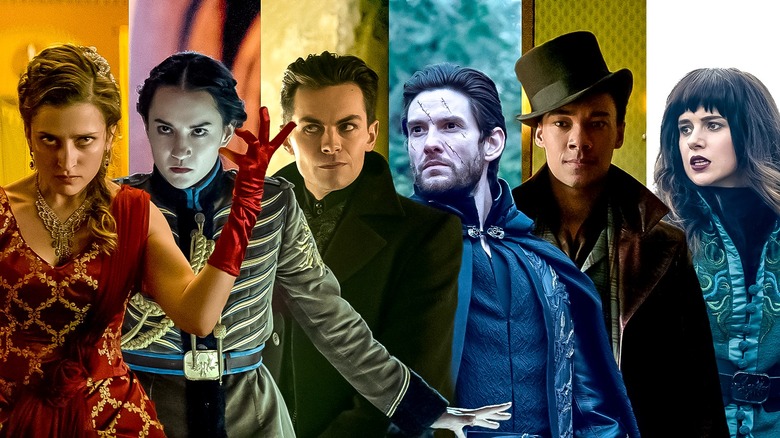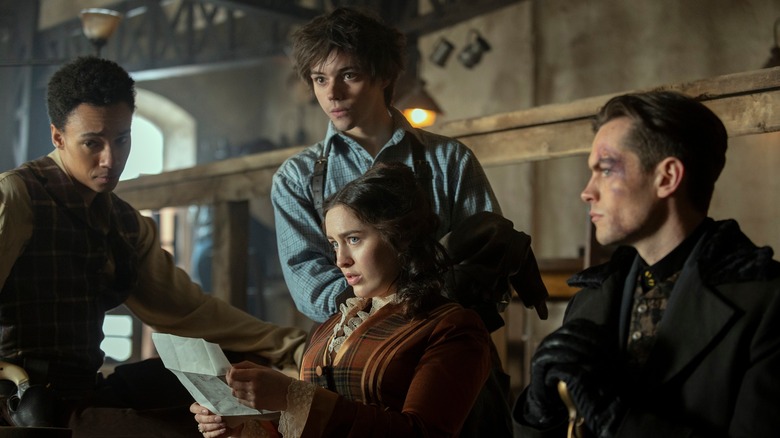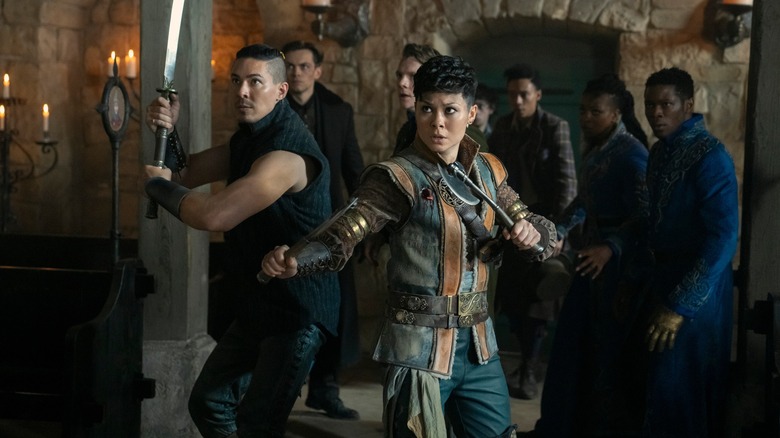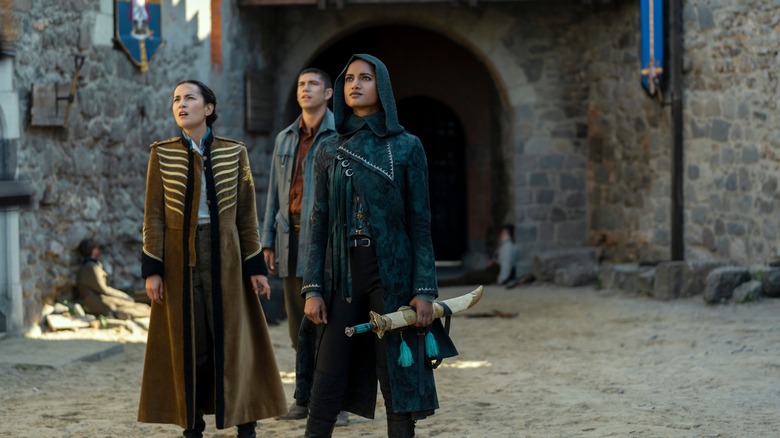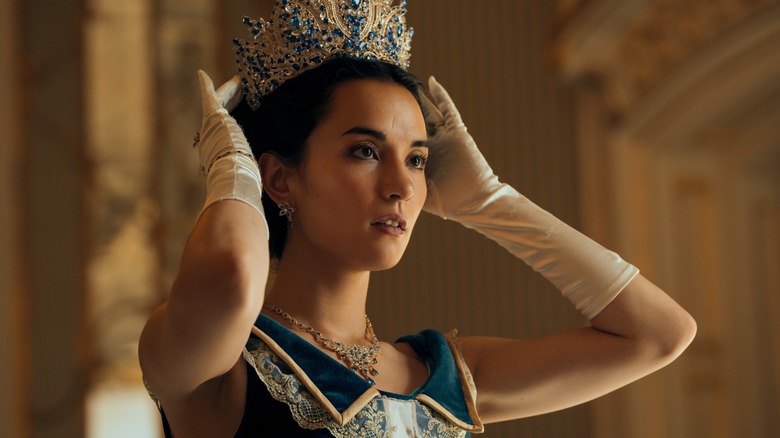Shadow And Bone Obliterates Its Source Material & Other Fantasy Adaptations Should Follow Its Lead
"The book was better." It's a phrase we've all heard so many times that it's practically a meme. Nearly every major work of modern screen adaptation will have its swathe of naysayers, sitting in the front row at the big premiere to chronicle all the ways it changes the source material. Many of the most successful book-to-film adaptations of late, like Peter Jackson's "Lord of the Rings" trilogy or the "Hunger Games" films, are applauded not just for their cinematic achievements, but for their loyalty to the books. Certainly, accuracy should be a factor when retelling a beloved story. But does it need to be the ultimate test of success?
Netflix's "Shadow and Bone" clearly believes otherwise. Season 1 set the stage with big changes to the main characters and a blended timeline, combining Leigh Bardugo's original Grishaverse trilogy with the successive "Six of Crows" duology. In Season 2, the show strays even further from the books. The latest installment incorporates storylines from multiple novels and a ton of original content, creating a rich and riveting saga that thrives on its willingness to break the mold.
To be fair, not all fans are happy with these big changes. Some feel that Netflix has ruined "Shadow and Bone" by rejecting the books. Again, let's pose the question: Does a TV show based on a series of fantasy novels need to be loyal to be a successful adaptation? "Shadow and Bone" says no — it just needs to be a fantastic series on its own. And it is.
The blended timeline in Shadow and Bone makes the story much richer
In the Grishaverse novels, the "Six of Crows" duology doesn't begin until after the end of Alina Starkov's story. It deals with some of the effects of the original trilogy on the world, but the two spin-off books largely exist in their own space. Obviously, the Netflix series undoes that whole chronology by making the Dregs gang central to Alina's journey. This was a fantastic decision in the translation from page to screen, and Leigh Bardugo herself has explained why.
"It makes the world feel bigger," Bardugo told The Guardian in 2021 when asked about the combination of the two series. "It's a much more fitting introduction to a universe that I've been working on for a decade now." If you're a part of the Grishaverse fandom, you'll be well aware that the "Six of Crows" books are generally viewed as the best. By deviating from the hero's journey that Alina goes on, the Dregs are able to fill in all the little corners of the world that make it feel so alive.
In an age when streaming series — and especially big-budget Netflix shows — are regularly cancelled midway through, it was a smart call to blend the Crows in with the Sun Summoner from the start. It establishes the universe twice as quickly, diversifies the storytelling, and helps keep the narrative momentum up when Alina's in-between the action.
Shadow and Bone is great television, and that's all that matters
The inclusion of the Dregs in "Shadow and Bone" is a big change, but one that most viewers seem to be happy with. After all, the characters are quite popular. The show's more controversial rewrites begin in earnest with Season 2, where numerous books are thrown into a blender and turned into an eight-hour YA parfait. "Siege and Storm," the middle entry in Alina's saga, is rushed through at a breakneck pace, and the climax of the Shadow Fold arc plays out much differently than in "Ruin and Rising."
But here's the thing: put matters of accuracy aside, and "Shadow and Bone" Season 2 is great television. It's a nonstop stream of twists, betrayals, action set pieces, and genuinely affecting personal moments. It spreads a unified thematic message across all of its disparate storylines — that power can be a weakness, and that vulnerability can be a strength. It embraces the trope-laden stylings of its YA nature and shifts them into overdrive, while simultaneously treating its characters with so much nuance and respect that the clichés never feel cheap. Season 2 may be more divisive than its predecessor, but it's still been a huge hit with both viewers and critics. It's fantastic fantasy and peak YA, and that's all it needs to be.
The easiest way for a book to fail is to try to be a TV show. The reverse is equally true. "Shadow and Bone" was designed to bring in new fans who'd never read the books, and it makes the changes necessary to do so.
Adaptations like Shadow and Bone should be opportunities to fix, tighten, and improve
"Shadow and Bone" wasn't adapted in a vacuum. Leigh Bardugo is credited as an executive producer on the series, and her involvement in Season 1 in particular was pretty significant. Though she told Collider that, if the show made it to a second season, "I was going to take a step back from the adaptation process and be a little bit less hands-on" for Season 2, she led the charge on many of the show's big initial changes.
"I am very proud of 'Shadow and Bone' but it is laden with tropes," the author told The Guardian in 2021, referring to the first book in the series. "I felt I could reflect our world more authentically. I look back and see mistakes that I wish I could alter." Many of these changes meant making the Netflix series less, in her words, "straight, white and homogenous." However, Bardugo wanted to improve more than just the representation. She entered the adaptation process looking to make something new, not to simply recreate what she had already written. The intention, from the outset, was never to faithfully adapt her prior work.
And it has been a new beast, indeed. Thank the Saints for that. For too long, screen adaptations have been hindered by the pressure to simply recreate their source material. They're expected to merely be moving illustrations in some special-edition, leatherbound tome. What a wasted opportunity for expansion and iteration that is — especially in the realm of fantasy.
Fantasy adaptations can never be fully loyal, and Shadow and Bone understands this
Fantasy has always thrived on the written page. It's the genre of what-ifs, imagination, and impossible things. It's only within the last few decades that serious, big-budget fantasy adaptations have broken through into the mainstream, first with the "Lord of the Rings" films and later with "Game of Thrones" on the TV end.
The modern renaissance of fantasy television has obfuscated an irrefutable fact, which is that fantasy in particular will always lose something by moving to a visual medium. There is no perfect way to show the impossible magics of a world that doesn't exist. There is no one portrait of Ketterdam or Ravka that can match each individual reader's vision. Why are popular book series adapted so often? Because a pre-existing fan base makes the investment a surer studio bet. Adaptations are cash grabs at their core, but only if we let them be. Only if they ignore original artistry and rely solely on name recognition.
"Shadow and Bone" respects its source material. It treats the world of the Grishaverse with love and complexity, but it isn't scared of changing things to fit its new form. Great fantasy adaptations will always demand sacrifices — just ask Tom Bombadil. But what Leigh Bardugo knows, and what "Shadow and Bone" knows, is that there's also no purpose in telling the exact same story twice.
